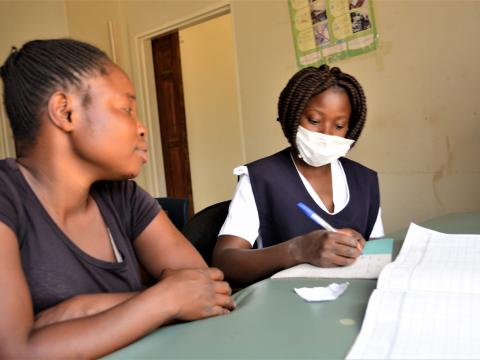New maternity annexe leads to increased demand for maternal services

Poor health services and lack of maternity space forced women in Chibombo District of Central Province to prefer giving birth from home over visiting the nearest health centre, Mwachisompola Rural Health Centre, due to lack of maternity space. To promote maternal health and increase women’s health service seeking behaviour, World Vision constructed a maternity annexe and installed mechanised water system at Mwachisompola Rural Health Centre.
“The new maternity annexe and water system constructed at the health centre have encouraged a lot of women to come to the health facility for maternal services. Previously, we only had a small annexe that accommodated one bed for delivery, and no prenatal or post-natal rooms", says a-25-year-old Patra Katoba, a mother of two. "But now, women have stopped home deliveries due to the well-equipped facility. I gave birth to my second child in the new annexe six months ago."
The person-in-charge at the rural health centre, Castro Mulenga, notes that before World Vision developed the new maternity wing, women used to give birth while waiting to be attended to because the old maternity wing is too small, and can only accommodate one bed.

“We used to have situations where some women were giving birth on the floor, and even when one gives birth without complication, they would immediately be discharged because the space was not enough for them to be kept for observation. Additionally, the same maternity annexe was used for family planning, so there was no privacy for women in labour. Consequently, this led to high home-based deliveries, because women shunned coming to the health centre as a result of the insufficient space”, Mr. Mulenga explains.
He further adds that the coming of the new maternity annexe has helped improve their service delivery to women, and other services seekers. "It is very spacious and can accommodate more women. We have three labour rooms, prenatal and postnatal spaces. This has led to increased demand from women around the community. The health centre is now receiving a significant number of women coming to seek family planning and maternal health services", he says. "This is as a result of the new annexe built by World Vision.”
During COVID-19, Mr. Mulenga and his colleagues have had a lot of challenges, especially with the lack of Personnel Protective Equipment (PPE), which made it difficult to respond to the rising crisis in the community. In response, World Vision assisted the health facility and the community with appropriate materials to be able to fearlessly attend to health service seekers. Materials included gloves, hand sanitisers, chlorine, thermometers and face masks, to mention but a few.
“World Vision has helped us deliver our services to the people; they have equipped the facility and empowered us with necessary materials to serve the community. Additionally, they trained the community members on COVID-19 management and awareness. This helped in sensitising the community on the virus, including its prevention, spread and treatment”, shares Mr. Mulenga.
Working with partners, World Vision has impacted the lives of over 200 million vulnerable children by tackling the root causes of poverty, globally.
“We work with the Zambian Government through the Ministry of Health to ensure that expectant mothers and children receive the best health service”, says Keembe/Musosolokwe Cluster Team Leader, Towera Mzumara. “We cannot rest until preventable maternal and child deaths are a thing of the past. We will continue to do everything we can to ensure women and children have access to the healthcare they need in our catchment area.”